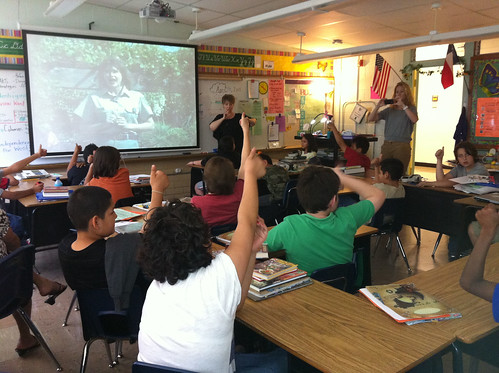Fourth-grade teacher Theresa Artman sat her students in front of a large monitor in her Austin, Texas, classroom. But they weren’t alone.
The Joslin Elementary School students were just some of the thousands of children across the country who watched the April 13 webcast of PollinatorLIVE from the Lady Bird Johnson Wildflower Center. Tamberly Conway, a conservation education coordinator for the U.S. Forest Service hosted the show.
PollinatorLIVE is a multi-agency conservation education program lead by the Forest Service that provides teachers and students with informative and interactive ways to learn about pollinators.

“My class really enjoyed watching the webcast of PollinatorLIVE,” Artman said. “Of course, they were excited to see some familiar kids in the show, but they were just as excited to learn about pollinators. One of the best parts of the program was when Tamberly would ask the audience questions. They were actually raising their hands and calling out responses as if Tamberly was right there in our classroom.”
Artman said the program kept the children examining their own knowledge base.
“My kids had so many great questions,” Artman said. “One student, Emily Mancilla, said, ‘I wonder where pollen comes from? Can we ask them that?’
“I emailed many questions and although none of our email questions were selected for the show, the students were amazed that the questions that were read were submitted by students and teachers in different states all over the country. They really understood that it was bigger than Austin, Texas. Students all over were watching and learning about the same thing at the same time.”
Artman said she already sees where the program can have a lasting effect on students.
“Two of my students told me after watching the program they were going to be scientists when they grow up,” she said. “We really enjoyed this interactive learning experience, and our students are ready to apply their learning in our campus wildflower garden!”
Part of the PollinatorLIVE goal is to excite young people to understand and appreciate natural resources. The program also encourages students and schools to develop gardens that can be home to a variety of pollinators, an activity that is in line with First Lady Michelle Obama’s Let’s Move! initiative that is about putting children on a path to a healthy future. An aspect of the initiative, Let’s Move Outside, is aimed at getting kids active outdoors not just to exercise but as a fun way to explore the great outdoors.
The PollinatorLIVE webcasts are archived online. The April 13 webcast will be available April 20.
